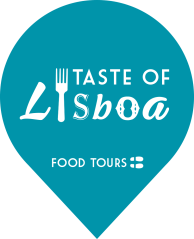What Portuguese and Spanish cuisines have in common – and what’s different between them
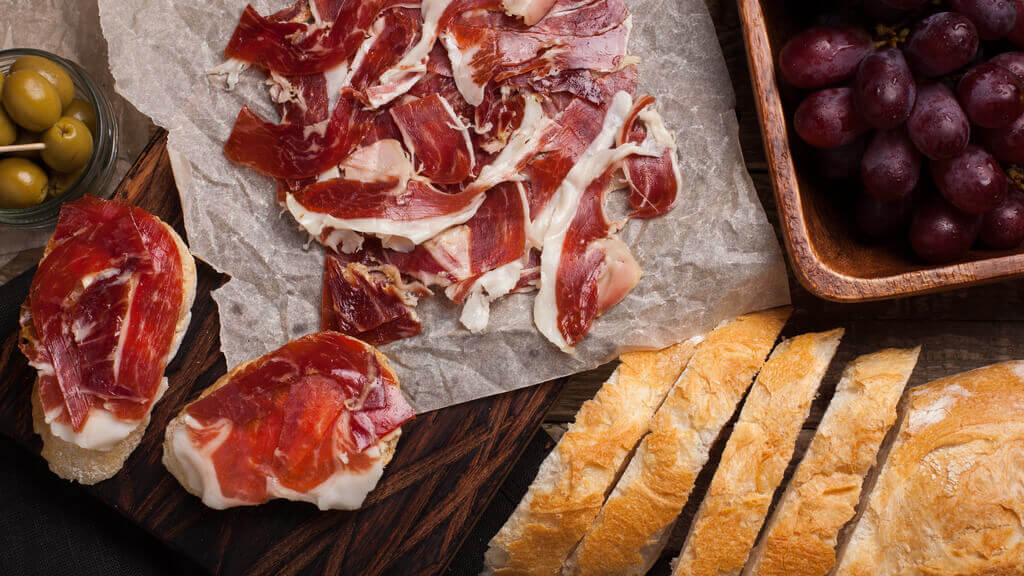
“Where can I find the best paella in Lisbon?”
“Oh my… Portuguese jamón is really good!”
“Portuguese and Spanish foods are pretty much the same…”
These are words you won’t hear coming out of the mouth of someone who’s truly knowledgeable about Portuguese or even Spanish food. Indeed the cuisines of both Portugal and Spain have lots in common, and it obviously makes sense thinking about our geographical proximity and historical backgrounds, but they also have some key differences which set them apart, and which have come up during history, thanks to several socio economic factors.
The Mediterranean diet and the Atlantic diet
The Mediterranean diet is consistently highlighted as one of the best in the world. Its principles focus on eating habits as well as lifestyle which is essential for a healthy life. We’re talking about putting an emphasis on the consumption of seasonal vegetables, fruits, whole grains, a limited amount of animal protein (including meat, fish, eggs and dairy), and healthy sources of fat such as olive oil. Even though the consumption of animal protein has increased in recent decades due to a higher purchasing power, the Mediterranean diet, which besides food focuses on the importance of community, sharing and socializing around the table, is still the prevalent diet across Spain.
In Portugal, on the other hand, only the southernmost region of the country, the Algarve, follows the Mediterranean diet closely. We did more so roughly until the 60s, when different economic and political situations influenced our agricultural and eating habits. Today, most of Portugal follows the Antlantic diet, in specific the Southern European Atlantic Diet (SEAD), something we do share with the Spanish region of Galicia. The Atlantic diet follows some of the principles of the Mediterranean diet, but it includes more animal protein than the Mediterranean one, namely a variety of fish and other seafood, including the imported cod from the north Atlantic, which we salt cure here in Portugal itself. Fun fact: Portugal is the highest consumer of fish in the European Union, with more than 50 Kgs per person, per year.
Prato do dia vs Menú del día
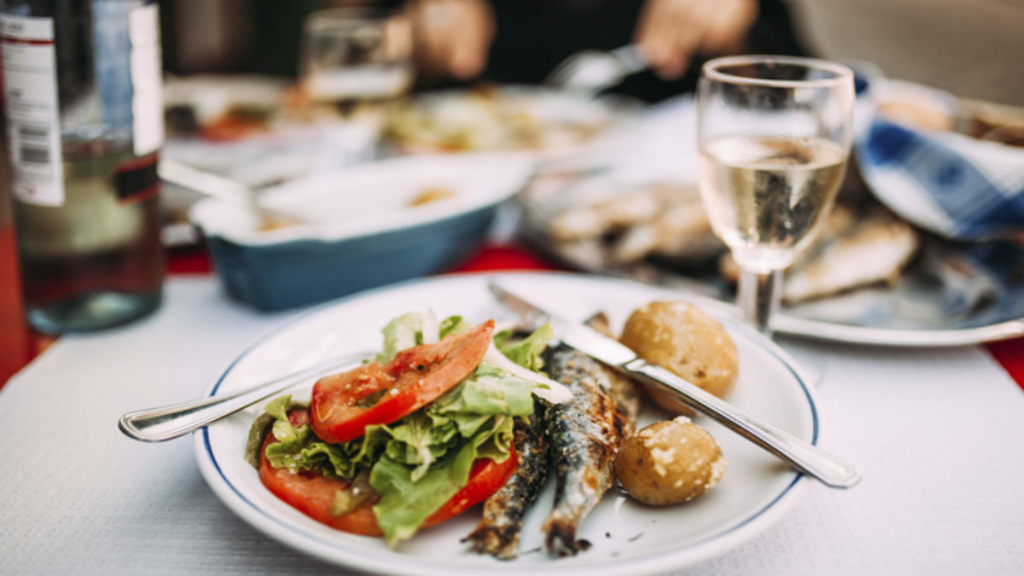 Eating lunch out during working days is not at all uncommon, both in Portugal and in Spain. Simple restaurants and, in the case of Portugal, even pastry shops (pastelarias) which double as lunch venues, offer good value for money combos for lunch, featuring daily specials. In Portugal this is called prato do dia, which literally translates as dish of the day, while in Spain this is called menú del día, which is the menu of the day. As the name clearly indicates, the Spanish version of this affordable meal is more complete and, as such, it also tends to be a little more expensive than in Portugal.
Eating lunch out during working days is not at all uncommon, both in Portugal and in Spain. Simple restaurants and, in the case of Portugal, even pastry shops (pastelarias) which double as lunch venues, offer good value for money combos for lunch, featuring daily specials. In Portugal this is called prato do dia, which literally translates as dish of the day, while in Spain this is called menú del día, which is the menu of the day. As the name clearly indicates, the Spanish version of this affordable meal is more complete and, as such, it also tends to be a little more expensive than in Portugal.
In Portugal, prato do dia is essentially a dish made particularly on that day, and each establishment will usually have more than one. More often than not, there are at least two daily specials, with fish and meat proteins, which are usually advertised alongside a soup of the day, a bit more of a rarity in Spain. Some restaurants, but not all, will also sell menu do dia, featuring soup, a main meal, a drink and sometimes even an espresso coffee, which is customarily consumed after your meal. Alternatively, soup can be replaced by dessert. In Spain, this more composed menu is more common than a dish of the day by itself, and it includes pan (bread), primero (first dish, aka, appetizer), segundo (second dish, that is, the main meal), postre (dessert), bebida (drink – usually water, wine or a soda) and coffee. Unlike in most places across Portugal, where people care a great deal about sweets, Spanish dessert can be a store bought pudding or even a yogurt, something which in Portugal you’d only see happening in school canteens.
Tapas vs Petiscos
 Even though more and more businesses, particularly in the more touristic areas of Lisbon, start advertising that they serve tapas, the correct term in Portuguese would be petiscos. We understand that the word tapas is more easily recognizable by international travelers but, as a company that takes food as a tasty excuse to share with you Portuguese culture, we’d like to explain that in Portugal, the correct word would indeed be petiscos. The concept is pretty much the same: small dishes which are usually ordered to share, and are best enjoyed with a small group of friends, which allows for you to order a bigger variety.
Even though more and more businesses, particularly in the more touristic areas of Lisbon, start advertising that they serve tapas, the correct term in Portuguese would be petiscos. We understand that the word tapas is more easily recognizable by international travelers but, as a company that takes food as a tasty excuse to share with you Portuguese culture, we’d like to explain that in Portugal, the correct word would indeed be petiscos. The concept is pretty much the same: small dishes which are usually ordered to share, and are best enjoyed with a small group of friends, which allows for you to order a bigger variety.
Spain has chorizo and we have chouriço, both are cured sausages flavored with paprika. They have croquetas that feature a creamy bechamel filling, and we have croquetes made with a thicker mix of shredded meats. Both countries share a love for canned fish and other seafood, which first came about from the need to preserve the freshness of the catches, and that nowadays is done for the sake of flavor and texture development. In what eggs are concerned, Spain runs on tortilla Española, a potato omelet, while in Portugal we’re all about the scrambles, sometimes featuring cured meats such as farinheira, and other times keeping things on the vegetable side of life, with pieces of wild asparagus. Spain prefers calamari, while around Lisbon we’re all about the chunkier cousin of this mollusc, and ask for fried cuttlefish strips (choco frito) instead. The world of tapas and petiscos is wide and tasty and, if you’re looking to get started while in Portugal, we have plenty of irresistible recommendations for you!
In both Portugal and Spain, bread is always on the table
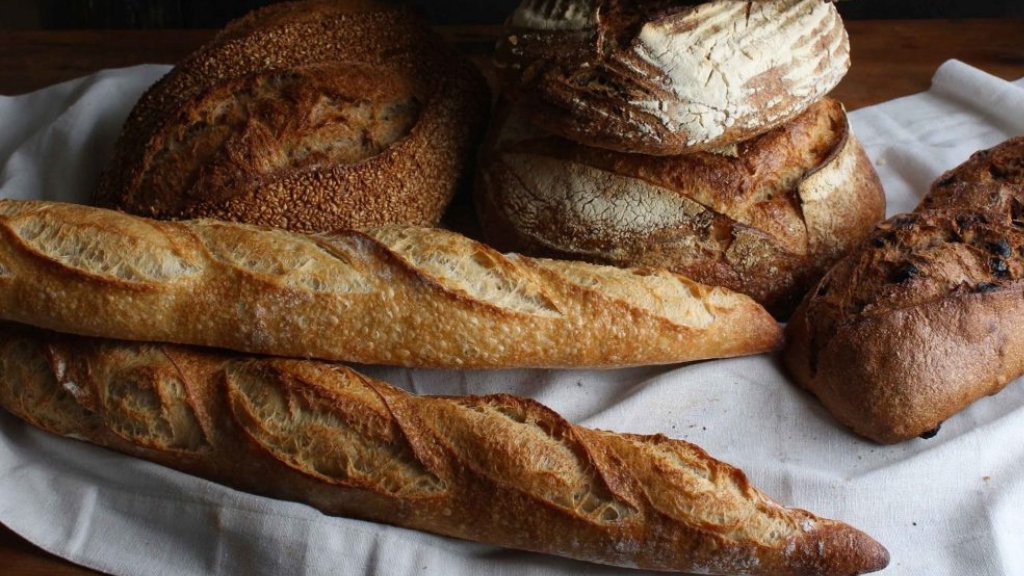 Whether you are eating tapas style, or having a proper sit-down meal, both in Portugal and Spain a bread basket will routinely be placed on the table, even if you didn’t ask for it. It’s understood that you will have bread no matter what your dish of choice may be. Now the main difference between Portugal and Spain in this regard is that, while in Spain the bread is free, or more correctly priced into the overall price of your meal, in Portugal you pay for it individually. Of course you are only charged if you indeed consume the bread, because even though it may be on the table, that doesn’t make it compulsory for you to eat.
Whether you are eating tapas style, or having a proper sit-down meal, both in Portugal and Spain a bread basket will routinely be placed on the table, even if you didn’t ask for it. It’s understood that you will have bread no matter what your dish of choice may be. Now the main difference between Portugal and Spain in this regard is that, while in Spain the bread is free, or more correctly priced into the overall price of your meal, in Portugal you pay for it individually. Of course you are only charged if you indeed consume the bread, because even though it may be on the table, that doesn’t make it compulsory for you to eat.
While both countries most used grain for bread is wheat, in Portugal we favor individual buns or loafs such as pão Alentejano or pão de Mafra, and the standard bread in Spain is a barra de pan, that is, a thicker style baguette type of bread format.
Drinking wine during meals is (almost) as common as drinking water
 This is one of the principles of the Mediterranean diet which Portugal didn’t dare to abandon as it slowly shifted more towards the Atlantic diet. Both Spain and Portugal are wine-growing regions with big productions, so it would only be normal that drinking wine is common, particularly during lunch and dinner. Unlike in other countries, it is perfectly normal to drink wine (or other alcoholic beverages such as beer) during a workday lunch – even if you’re going out with your boss. It’s sticking with this kind of habit that Portugal has become one of the biggest wine consumers in the world, something which we believe can be done in moderation, within healthy parameters.
This is one of the principles of the Mediterranean diet which Portugal didn’t dare to abandon as it slowly shifted more towards the Atlantic diet. Both Spain and Portugal are wine-growing regions with big productions, so it would only be normal that drinking wine is common, particularly during lunch and dinner. Unlike in other countries, it is perfectly normal to drink wine (or other alcoholic beverages such as beer) during a workday lunch – even if you’re going out with your boss. It’s sticking with this kind of habit that Portugal has become one of the biggest wine consumers in the world, something which we believe can be done in moderation, within healthy parameters.
Portuguese presunto vs Spanish jamón
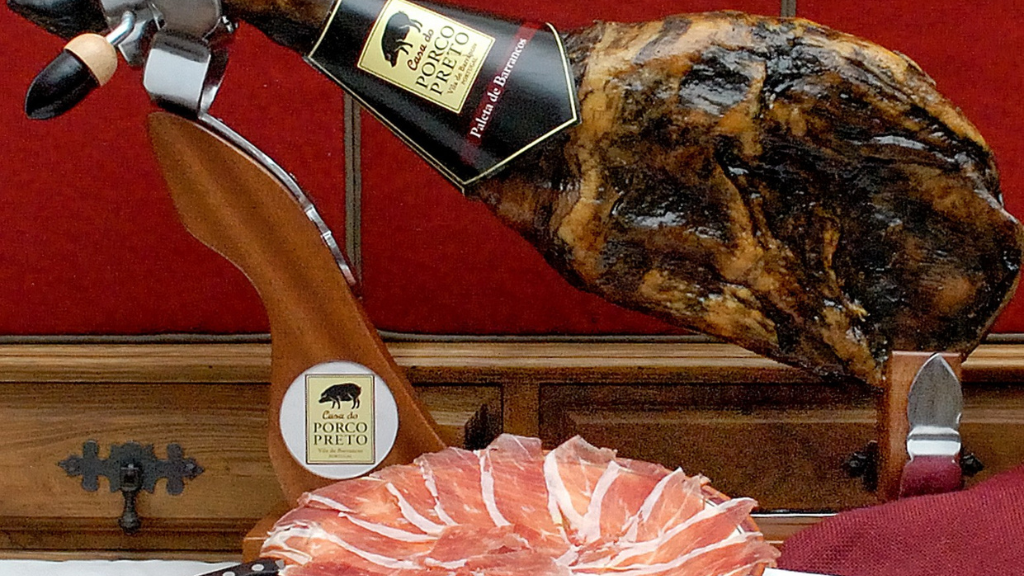 We have come across an international tourism company offering food tours in Lisbon, promoting that they “serve Spanish cured ham” during their experiences. What a cringy thing to put out there! Spain is known to have pata negra, while Portugal makes some of its more prized cured ham with porco preto. The animal breed used for this salt dried meat is the same. We’re talking about the Iberian black pig, which is believed to have originated from mixing wild boars with pigs brought over to the Iberian Peninsula by the Phoenicians from current-day Lebanon.
We have come across an international tourism company offering food tours in Lisbon, promoting that they “serve Spanish cured ham” during their experiences. What a cringy thing to put out there! Spain is known to have pata negra, while Portugal makes some of its more prized cured ham with porco preto. The animal breed used for this salt dried meat is the same. We’re talking about the Iberian black pig, which is believed to have originated from mixing wild boars with pigs brought over to the Iberian Peninsula by the Phoenicians from current-day Lebanon.
Today, cured ham is made from this pig or any other breed (such as the much praised Bísaro from the north of Portugal, which unlike Iberian pigs who feed free range on acorns, feed mostly on chestnuts) and enjoyed as part of charcuterie boards or in sandwiches. But the methods of production in both countries do vary a little. In Portugal, ham is dry-cured with salt, while in Spain it may also include garlic and even a few other spices, besides the mandatory salt.
The Moorish influence on both Portuguese and Spanish cuisines
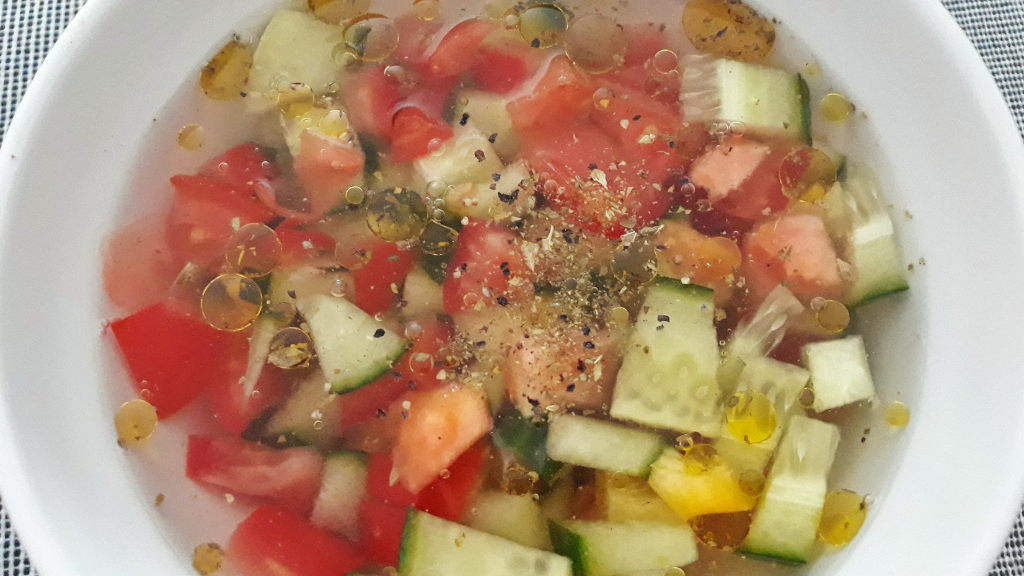 We have previously explored how the Moors from northern Africa (namely the Maghreb region) have heavily influenced Portuguese food growing and eating habits. But when we look into the Arabic presence with a more holistic perspective, we ought to point out that they were present not only in what is now-a-days Portugal, but also Spain, that is, the whole of the Iberian Peninsula, with particular long lasting effects in the southernmost parts of both countries.
We have previously explored how the Moors from northern Africa (namely the Maghreb region) have heavily influenced Portuguese food growing and eating habits. But when we look into the Arabic presence with a more holistic perspective, we ought to point out that they were present not only in what is now-a-days Portugal, but also Spain, that is, the whole of the Iberian Peninsula, with particular long lasting effects in the southernmost parts of both countries.
Present in our countries particularly between the 7th and the 12th centuries, during the so-called Middle Ages, the Moors brought with them new ingredients, cooking techniques and a wider appreciation which had an impact on the way we eat until today. It was them who, for example, introduced citrus inside the Iberian Peninsula – and what would Spanish Andalucia or the Portuguese Algarve regions be without the sights and scents of orange blossoms during Spring? It was also the Moors who introduced deep-frying and grilling over charcoal as cooking techniques, something that still defines the cuisines of Spain and Portugal to quite an extent.
Rice was also introduced by the Arabs, even though different recipes were over the years and centuries developed in Portugal and Spain. While paella, from the region of Valencia, is widely regarded as one of the most iconic Spanish dishes, here in Portugal we don’t prepare this dish or, if we do now-days, we call it arroz à Valenciana, that is, Valencia style rice, recognizing that is it indeed a dish from across the border. In Portugal, rice and seafood most commonly come together in a recipe called arroz de marisco (seafood rice), which is not as dry as pella, nor it features a crispy bottom (the famous socarrat which is supposedly make or break for a good paella). Portuguese seafood rice features a saucy concoction of local Carlino rice, swimming in a rich tomato based broth, with different pieces of fish and seafood, which vary according to the cook, budget and catch of the day.
One pot comfort foods, known in Portugal as comida de tacho and in Spain as potages, is something that evolved in this era, particularly with the popularization of beans and pulses, ideal to feed a crowd on a budget. The preferred methods would usually rely on slow cooking. The no-waste approach to cooking was also notable in the uses of bread, particularly stale bread. Both in Portugal and Spain, the Moors popularized cooking with dry loaves of bread, giving origin to Portuguese dishes like açorda, migas and even sweet rabanadas (Portuguese French toast), and their Spanish counterparts torrijas – which were back in the day drizzled with honey. Another notable use of old bread would come in the shape of gazpacho, or gaspacho in Portugal, which most of the world associates exclusively with Spain, but which is widely consumed in the Alentejo region too.
Spanish and Portuguese gazpachos are both delicious and particularly refreshing to eat during the summer, but the recipes are distinct. While in Spain gazpacho stands for a blended mix of tomatoes, cucumber, sweet bell peppers, onions, garlic, olive oil and crustless bread, the Portuguese version features the vegetables chopped into tiny pieces, swimming in ice cold water, as pictured here.
Thin noodles weren’t also a reality in the Iberian Peninsula until the 8th century, when the Arabs introduced vermicelli pasta. Both Spain and Portugal keep using these noodle for several culinary uses, but while in Spain they privilege savory recipes such as fideuá, a sort of variation of paella which substitutes the rice for pasta, here in Portugal our pronounced sweet tooth has lead us into a path of devotion for aletria, a pudding with angel hair pasta cooked in sweet milk with eggs.
If the gastronomic scene of the Iberian Peninsula can only be understood when looking at it through the lense of the massive influence the Moors had on it, along with the marks also left behind by the Romans, Christians and Jews, it’s interesting to note how, centuries later, Portugal and Spain also shared the influences from the New World, which started during the Age of Explorations in the 16th century.
Pour me a sangria and tell me where it’s from
 Let’s take a trip back in time, to the days of the Roman Empire, shall we? This is when the drink originated, as far back as the year 200 BC, even though the name sangria was more recently coined in the 18h century. Sangria originally came about from the need to kill the bacteria in water that wasn’t so pure. This was done by adding alcohol, in this case wine, which didn’t taste so good in and of itself, so other flavoring agents such as herbs and spices started being thrown into the mix too.
Let’s take a trip back in time, to the days of the Roman Empire, shall we? This is when the drink originated, as far back as the year 200 BC, even though the name sangria was more recently coined in the 18h century. Sangria originally came about from the need to kill the bacteria in water that wasn’t so pure. This was done by adding alcohol, in this case wine, which didn’t taste so good in and of itself, so other flavoring agents such as herbs and spices started being thrown into the mix too.
If sangria is widely associated with Spain today it is because of good marketing, as in Portugal it is also a fairly common drink, yet we don’t link it as closely to our gastro cultural identity. Back in 1964, Spain served sangria at its own pavilion in the World’s Fair, and it was such a hit that the drink’s popularity only grew from then onwards. Sangria, whose name derives from sangre (in Spanish) or sangue (in Portuguese) meaning blood as a reference to its dark red color, can be enjoyed in both Spain and Portugal, even though we have to give it to our neighbors that it is indeed more common across the border.
Spices and aromatic herbs
 Coriander (which was also introduced here by the Moors) is very popular in Portugal, especially in dishes from the southern Alentejo region, but it is rarely found in traditional Spanish cuisine. In Spain, just like it happens in the north of Portugal, the most commonly used fresh herb would be parsley, known in Portugal as salsa, and in Spain as perejil.
Coriander (which was also introduced here by the Moors) is very popular in Portugal, especially in dishes from the southern Alentejo region, but it is rarely found in traditional Spanish cuisine. In Spain, just like it happens in the north of Portugal, the most commonly used fresh herb would be parsley, known in Portugal as salsa, and in Spain as perejil.
The use of various spices also differs between Portugal and Spain. In Spain, for example, saffron, one of the essential ingredients to make paella, is much more widely used than in Portugal. But in Portugal we couldn’t live without fiery peppers, so important to make the peri-peri sauce the world has come to associate with Portuguese style chicken BBQ.
Desserts and conventual sweets
 When it comes to sweet dishes, perhaps the biggest similarities between Portuguese and Spanish desserts have to do with fritters, which are something that did evolve around here during Moorish times. But let’s focus on the curious case of churros for a moment: while the world largely associates churros with Spain (or, sometimes in the USA, even straightforwardly with Latin American, clearly because of Spanish influence during colonial times) the truth is that sweet dough fritters like churros and their thicker version known as porras in Spain and farturas in Portugal, are known to have originated in China, where they are called youtiao (pictured here). It was the Portuguese who brought them over to the Iberian Peninsula after having reached China after the 16th century. While it’s true that Spain introduced the use of the star-shaped nozzle which gives the characteristic shape which many of us have come to associate with churros today, as you can see, churros aren’t the most Spanish nor Latin thing ever after all. Unless, of course, they’re stuffed with dulce de leche…
When it comes to sweet dishes, perhaps the biggest similarities between Portuguese and Spanish desserts have to do with fritters, which are something that did evolve around here during Moorish times. But let’s focus on the curious case of churros for a moment: while the world largely associates churros with Spain (or, sometimes in the USA, even straightforwardly with Latin American, clearly because of Spanish influence during colonial times) the truth is that sweet dough fritters like churros and their thicker version known as porras in Spain and farturas in Portugal, are known to have originated in China, where they are called youtiao (pictured here). It was the Portuguese who brought them over to the Iberian Peninsula after having reached China after the 16th century. While it’s true that Spain introduced the use of the star-shaped nozzle which gives the characteristic shape which many of us have come to associate with churros today, as you can see, churros aren’t the most Spanish nor Latin thing ever after all. Unless, of course, they’re stuffed with dulce de leche…
Most other desserts you’ll find in Portugal today belong to our range of conventual sweets, that is, recipes which were once upon a time developed inside religious institutions. In Spain they also have dulces de convento, which are still often prepared inside monasteries and convents, even though this is not as culturally relevant as here in Portugal, where doces conventuais are a huge deal.
Do the Portuguese eat as late as the Spanish do?
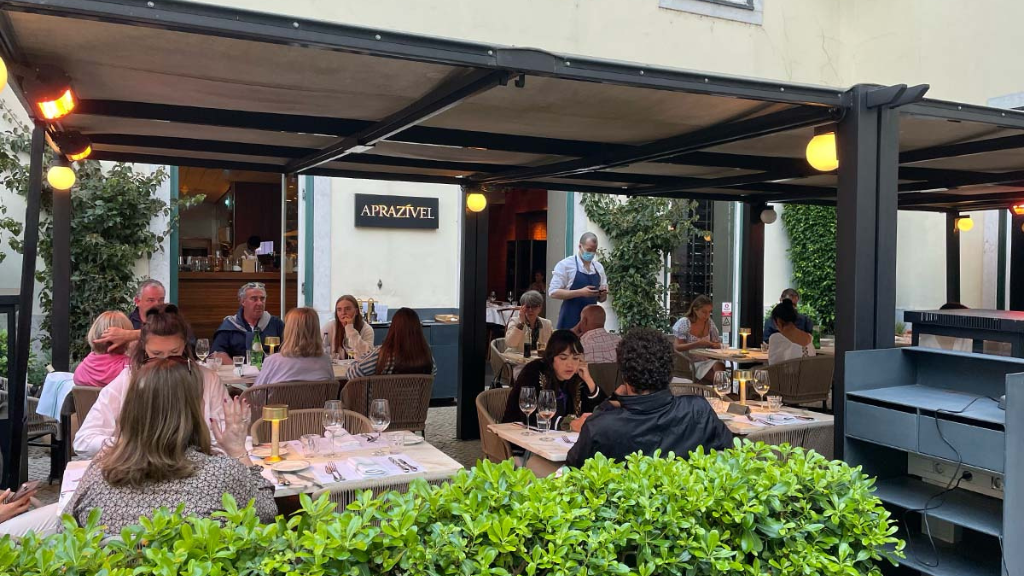 Even though visitors who come to our country from places such as North America or northern European countries do think we tend to eat fairly late, we’re nothing compared to nuestros hermanos. While main meal times in Spain tend to happen at around 2PM and 9PM to 10PM, here in Portugal most folks would start eating lunch somewhere between 12h30 and 13h, and dinner between 8PM and 9PM – more on this here. That doesn’t mean we won’t prolong the time we spend around the table as, particularly when going out to eat, we like doing so in a relaxed manner, enjoying appetizers, main dishes, deserts, coffee and perhaps another round of drinks, with plenty of conversations and laughter – and this is something we do indeed share with Spanish folks, who even have a specific word for the time spent around the table socializing well after you have properly finished your meal (this is called “sobremesa”, not to be mistaken with Portuguese sobremesa, spelled in the exact same way, but which simply translates as dessert).
Even though visitors who come to our country from places such as North America or northern European countries do think we tend to eat fairly late, we’re nothing compared to nuestros hermanos. While main meal times in Spain tend to happen at around 2PM and 9PM to 10PM, here in Portugal most folks would start eating lunch somewhere between 12h30 and 13h, and dinner between 8PM and 9PM – more on this here. That doesn’t mean we won’t prolong the time we spend around the table as, particularly when going out to eat, we like doing so in a relaxed manner, enjoying appetizers, main dishes, deserts, coffee and perhaps another round of drinks, with plenty of conversations and laughter – and this is something we do indeed share with Spanish folks, who even have a specific word for the time spent around the table socializing well after you have properly finished your meal (this is called “sobremesa”, not to be mistaken with Portuguese sobremesa, spelled in the exact same way, but which simply translates as dessert).
The foods of Portugal and Spain at a glance
If you’re still confused between the resemblance and variances between Portuguese and Spanish cuisines, let’s quickly recap:
Main similarities between Portuguese and Spanish foods:
- both countries are inside the Iberian Peninsula and have received civilizations with different cultures, most notably the Romans and Moors from northern Africa who have left a mark in our food culture;
- we share a common love for pork, and we both enjoy cured ham and have been doing so for centuries;
- some ingredients both countries truly love include onions, garlic, tomatoes, rice, fish and eggs;
- we both enjoy deep-frying sweet dough and calling it churros, but these actually originated in China.
Main differences between Portuguese and Spanish foods:
- Spain largely follows the Mediterranean diet, while in Portugal the Atantic diet is more prevalent these days;
- in Spain they do tapas, and in Portugal we do petiscos – it’s the same, but it’s also not the same…
- spices wise, saffron is very widely used in Spain, while not so much here in Portugal;
- in Portugal, we use lots of peri-peri and cinnamon, while in Spain they aren’t as essential as around here;
- we love both parsley and coriander, but Spain relies mostly on parsley for a fresh herby touch to its dishes;
- sangria is indeed a little more Spanish – we sure like to drink it too, but we ought to give credit where credit is due;
- here in Portugal we eat late… but in Spain they do it even later!
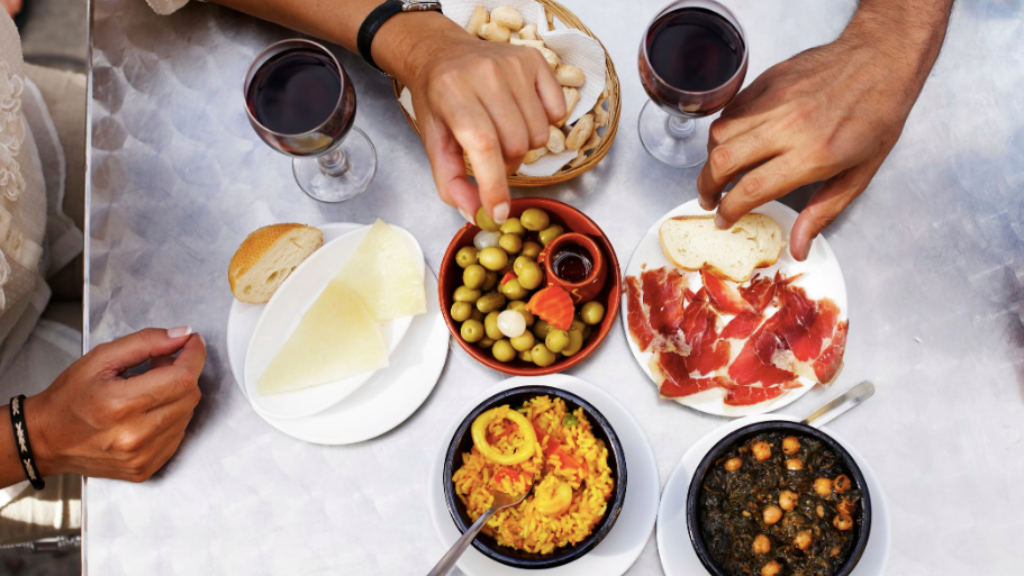
Has this article contributed to debunking any preconceived ideas about Portuguese food you might have had? We’d love to hear your thoughts on Instagram. Please tag us: @tasteoflisboa or #tasteoflisboa
Feed your curiosity on Portuguese food culture:
Foods you didn’t know were Portuguese
Portuguese foods inherited from the Moorish occupation
Travel around Portugal in 18 foods (without leaving Lisbon)
For the love of cod: a historical look behind Portugal’s obsession with bacalhau
Real people, real food. Come with us to where the locals go.
Signup for our natively curated food & cultural experiences.
Follow us for more at Instagram, Twitter e Youtube
